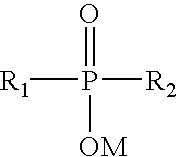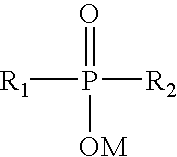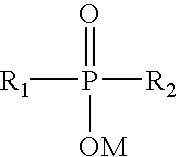Particulate inorganic solids treated with organophosphinic compounds
- Summary
- Abstract
- Description
- Claims
- Application Information
AI Technical Summary
Benefits of technology
Problems solved by technology
Method used
Image
Examples
example 1
In this example, 0.90% of diisooctylphosphinic acid is added to dry chloride process rutile TiO2 base, which was coated with 0.20% alumina.
26.8 ml of a 386.4 grams Al2O3 / liter solution of sodium aluminate were added to 5,230 grams of fine particle chloride process TiO2 in a 350 grams / liter slurry with mixing at 70° C. The slurry pH was adjusted to 7.0 using a 50% sodium hydroxide solution, and the slurry was allowed to age for 30 minutes with stirring. The aged slurry was filtered and washed two times with 5000 ml aliquots of 80° C. deionized water, and then dried overnight at 115° C. in an oven. The dried filter cake was forced through an 8-mesh screen in preparation for treatment with diisooctylsulfonic acid.
9.0 grams of diisooctylphosphinic acid (Fluka Chemical) were added drop wise in a circular motion to 1000 grams of the dry, 8 meshed, alumina coated TiO2 prepared as described above, which was spread to a 1 cm thickness on polyethylene film. The pigment was mixed with a l...
example 2
In this example, 1.10% of diisooctylphosphinic acid is added to dry chloride process rutile TiO2 base, which was coated with 0.20% alumina.
11.0 grams of diisooctylphosphinic acid (Fluka Chemical) were added drop wise in a circular motion to 1000 grams of the dry, 8 meshed, alumina coated TiO2 prepared as described in example 1, which was spread to a 1 cm thickness on polyethylene film. The pigment was mixed with a large spatula and transferred to a one gallon wide-mouthed Nalgene bottle. The bottle containing pigment was rolled for 10 minutes on a roller mill. The rolled pigment was steam micronized to produce the finished pigment.
The finished pigment was incorporated into 75% and 50% TiO2 containing low-density polyethylene masterbatch for dispersion and lacing evaluations, respectively. Results are given in Table 1.
example 3
Preparation of di-n-octylphosphinic acid. To a stirred mixture of 46.5 g (0.261 mol) of n-octylphosphinic acid in 250 mL 95% ethanol, 1-octene (58.6 g, 0.5218 mol) was added followed by 9.042 g (0.026 mol) of 70% benzoyl peroxide. The resulting mixture was refluxed for 8 hs, and then another 6.758 g (0.0196 mol) of benzoyl peroxide was added and the reaction continued to reflux for an extra 8 hs. A third 4.244 g of benzoyl peroxide was added (0.01305 mol) and refluxing continued for an extra 8 hs. The resulting mixture was cooled in the refrigerator, filtered, and 111.8 g of di-n-octylphosphinic acid was recovered using a rotary evaporator. The solid was washed with 100 mL of cooled 95% ethanol and the filtrate was concentrated on the rotary vacuum and replaced in the refrigerator. Another 24.9 g di-n-octylphosphinic acid was obtained on cooling to attain a total of 36.7 g (48.4% yield).
PUM
| Property | Measurement | Unit |
|---|---|---|
| Fraction | aaaaa | aaaaa |
| Fraction | aaaaa | aaaaa |
| Fraction | aaaaa | aaaaa |
Abstract
Description
Claims
Application Information
 Login to View More
Login to View More - R&D
- Intellectual Property
- Life Sciences
- Materials
- Tech Scout
- Unparalleled Data Quality
- Higher Quality Content
- 60% Fewer Hallucinations
Browse by: Latest US Patents, China's latest patents, Technical Efficacy Thesaurus, Application Domain, Technology Topic, Popular Technical Reports.
© 2025 PatSnap. All rights reserved.Legal|Privacy policy|Modern Slavery Act Transparency Statement|Sitemap|About US| Contact US: help@patsnap.com



